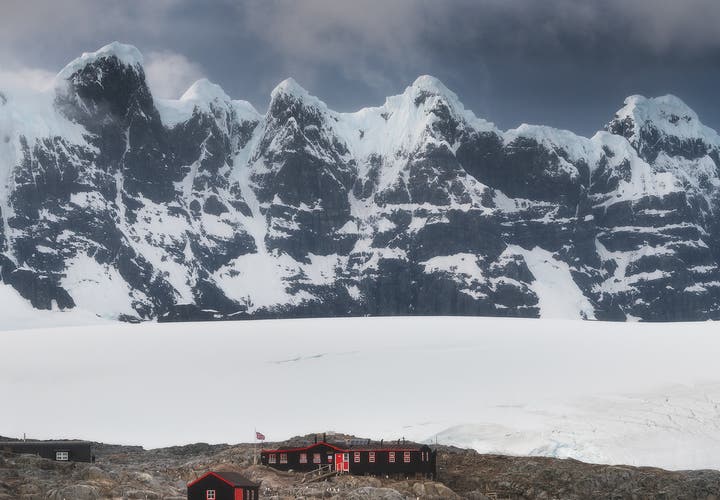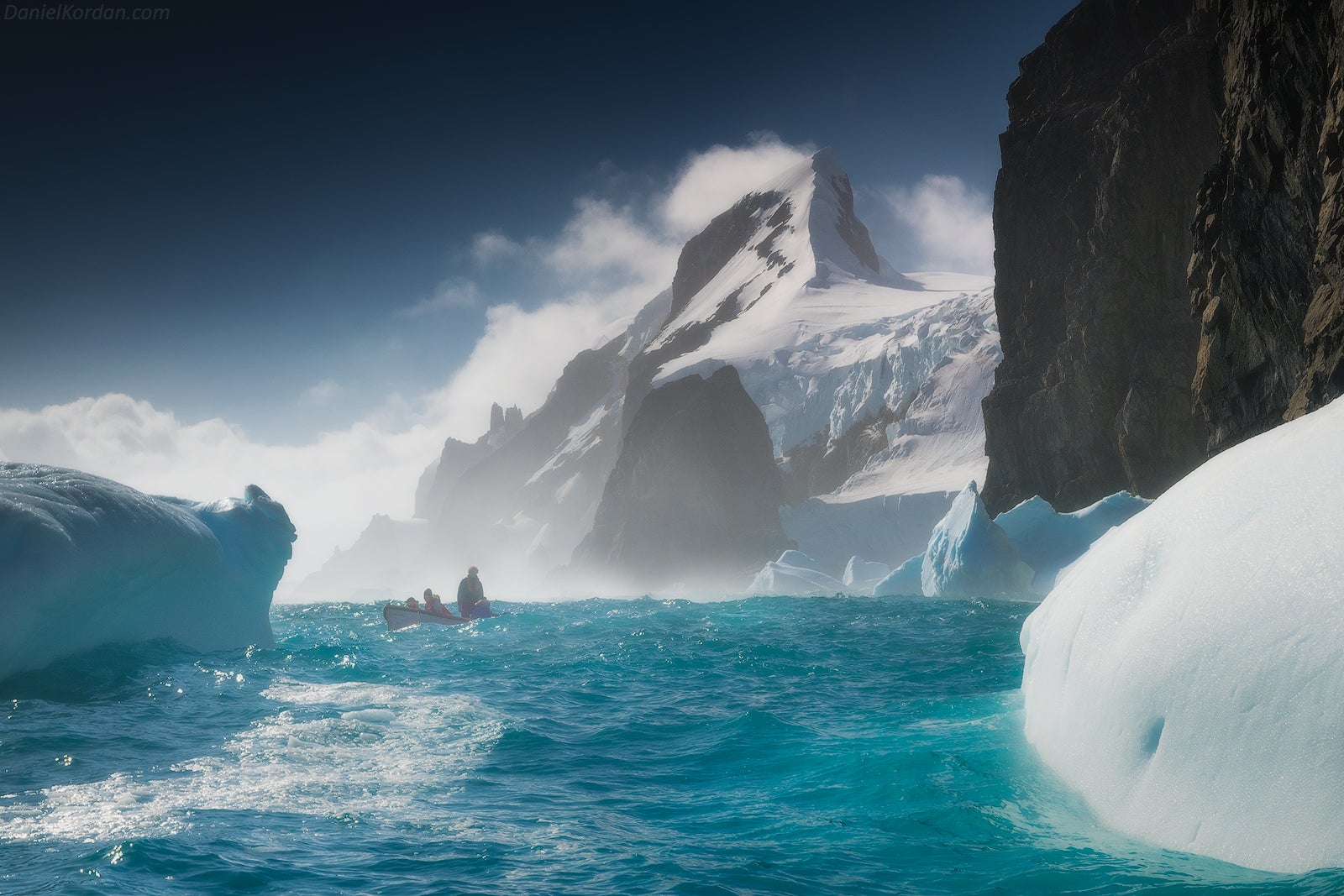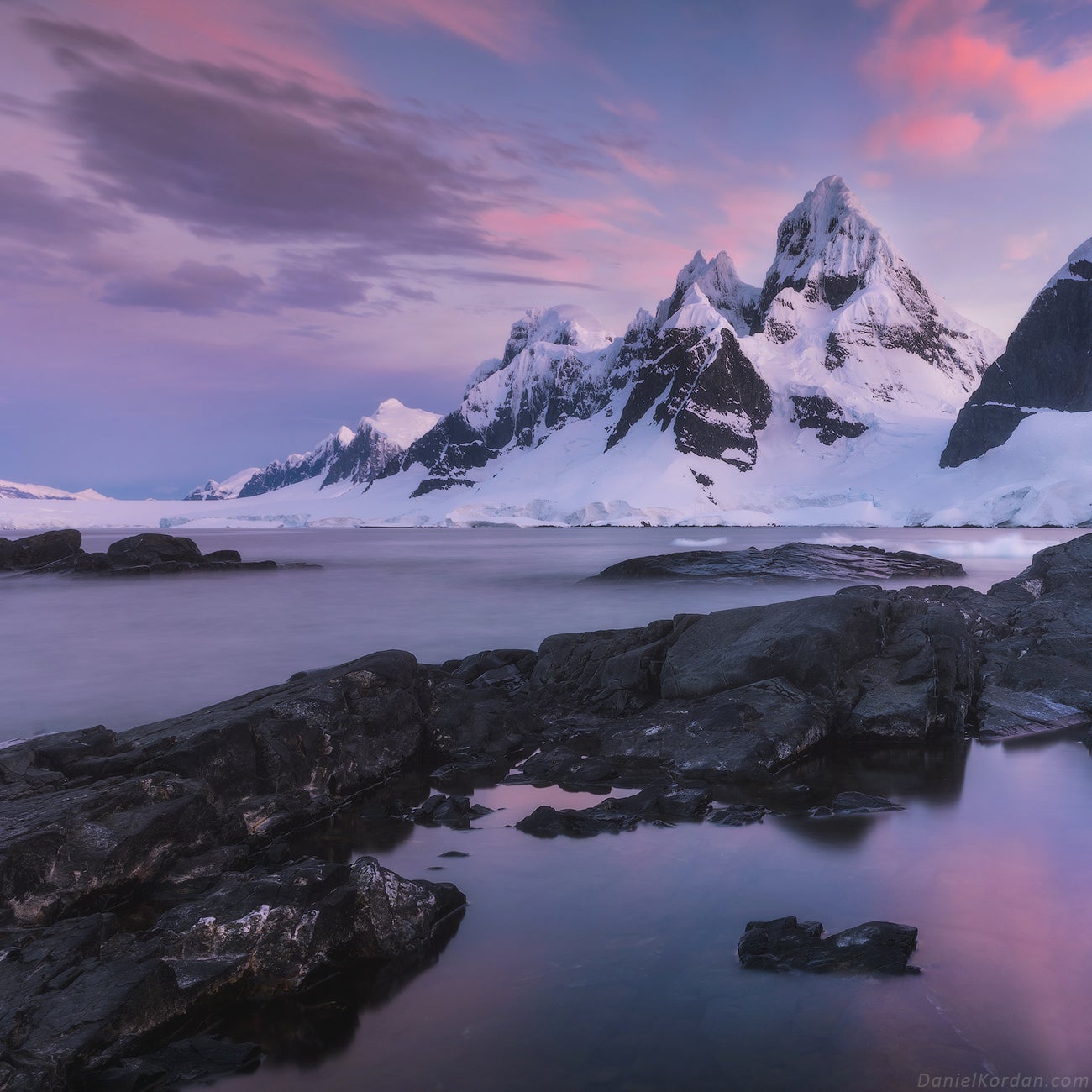
What animals live in Antarctica? Are any animals endemic to continent, and have any been introduced? How does any wildlife survive in the conditions of the south pole? Read ahead for the ultimate guide to animals in Antarctica.
- Explore these articles on Wildlife Photography
- Discover this Namibia Wildlife Photography Tour
The world’s southernmost continent is renowned for its incredible wildlife. In the tumultuous, stormy seas, across the stark and hostile snowscapes, and on the unforgiving sheets of ice, some of the world’s most impressive animals can be found thriving.
Seals up to six metres long battle on the beaches; Emperor Penguins gather in vast colonies to rear their young; the greatest of whales feed, breach and socialise in the fertile seas; and countless seabirds, including the mighty albatross, soar through the pristine skies.
 Penguins are Antarctica's most iconic animal. Photo by: 'Daniel Kordan'.
Penguins are Antarctica's most iconic animal. Photo by: 'Daniel Kordan'.
Their beauty and rarity, as well as their fascinating behaviours and the spectacular lands they inhabit, have inspired countless documentarians and filmmakers to chronicle their lives. Epics such as March of the Penguins, Blue Planet and Planet Earth have brought these wonderful creatures into the homes of countless people across the globe, and as such, the passion for knowledge on Antarctica’s wildlife is ever-growing.
This is especially true as more and more realise that there are many opportunities they can take to witness the continent’s wildlife themselves. Antarctic cruises from South America, South Africa and New Zealand offer a glimpse into this fascinating ecosystem and provide plenty of chances to look out for whales and seabirds.
Photography workshops, meanwhile, will get you even closer to the action, immersing you amongst colonies of seals and penguins which, due to lack of exposure to humans, are largely unafraid of your presence.
 Many great whales migrate to Antarctica for the austral summer. Photo by: 'Daniel Kordan'.
Many great whales migrate to Antarctica for the austral summer. Photo by: 'Daniel Kordan'.
Take, for example, this twelve-day photography workshop, available in 2020 and 2021. Conducted from the Greg Mortimer, a modern ship designed for traversing the unpredictable waters of the Antarctic, you will make multiple trips by zodiac to the continent’s coastline and ice sheets to witness an array of spectacular creatures up close, including albatross, Elephant Seals, Chinstrap and Emperor Penguins, and perhaps even the largest creatures ever to exist on Earth, Blue and Fin Whales.
As this tour is led by an expert expedition team, you’ll be able to learn a wealth of information about the animals as you capture your memories of their beauty and dramatic behaviour on film. Furthermore, you’ll be guided by an award-winning photographer, Daniel Kordan, who will help you get the best shots possible, provide seminars on taking better pictures, and help you with post-production. The Greg Mortimer even has an arts room for processing and editing photos.
Regardless of whether you wish to simply learn about these spectacular creatures from the warmth of your home, or whether you are seeking the holiday of a lifetime to photograph their majesty up close, the animals of the Antarctic are some of the world’s most inspiring creatures. As such, we have compiled this ultimate guide to provide you with some fascinating facts about the animals of Antarctica.
- See also: An Interview with Daniel Kordan
Penguins in Antarctica
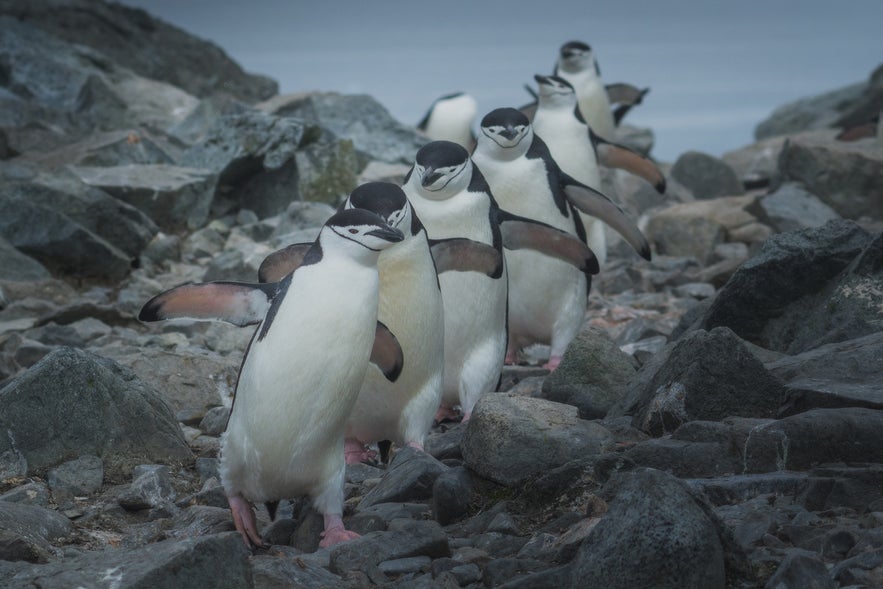 The most iconic Antarctic animals are the penguins. Photo by: 'Daniel Kordan'.
The most iconic Antarctic animals are the penguins. Photo by: 'Daniel Kordan'.
Though this article has a section dedicated to the birds of Antarctica, it would be unseemly not to provide penguins some discussion in their own right. Eight species make their home on or around the continent, with two endemic, and in many ways, they have come to be the face of it. Emperor Penguins huddling against an otherworldly blizzard; lifelong couples reuniting after weeks apart at sea; fluffy chicks snuggled between their parent’s legs; and individuals belly sliding across the ice are all images intrinsically tied to the Antarctic.
Perhaps this partly comes from childhood, where schools teach us that polar bears represent the north pole and penguins represent the south. Perhaps it is because of their humanlike characteristics, with their deep social bonds or the way they waddle on two feet. Perhaps it is because of their role as protagonists, comic relief or simply the cute-factor in countless films, such as Surf’s Up, Madagascar, Happy Feet and 2019’s Penguins.
Regardless, penguins not only the most classic representations of the Antarctic but are some of the most adorable and beloved creatures that reside in it.
Emperor Penguins in Antarctica
Emperor Penguins, the largest of all penguins, are undoubtedly the most iconic species in the family, and the most associated with Antarctica; they are one of only two endemic to the continent. Due to their vivid colouration, the vast colonies they associate in and their size (around 1.1 metres tall and averaging out at 35 kilograms), Emperor Penguins have been the subject of countless films, and are one of the most easily photographed creatures on the aforementioned workshop.
It is not only their size that differentiates Emperor Penguins from other species, but also their behaviour. Unlike any other, they lay and hatch their eggs in the winter, and as such, their entire lives revolve around surviving and protecting their offspring during this season’s violent conditions.
Emperor Penguins start to breed between three and five years of age, starting their courtship as Antarctica’s midnight sun (brought about due to the axis of the Earth in summer) begins to significantly fade, around March and April. They travel to their nesting areas inland, often over 100 kilometres away, to protect themselves from the worst of the winter weather and to avoid the sea ice breaking at the start of spring.
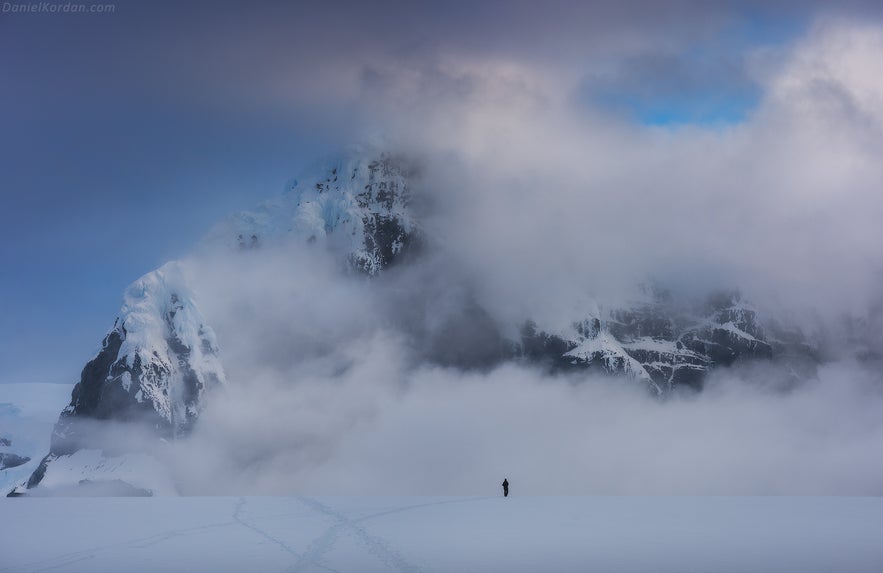 Antarctica is a freezing land, difficult for the vast majority of animals to live in; Emperor Penguins do so permanently. Photo by: 'Daniel Kordan'.
Antarctica is a freezing land, difficult for the vast majority of animals to live in; Emperor Penguins do so permanently. Photo by: 'Daniel Kordan'.
Contrary to much of the misinformation on the internet, Emperor Penguins are not monogamous. Each year, the male will vocalise and waddle around the colony as a courtship display until he finds a willing female, which only 15 percent of the time will be the same as his partner from the year before.
In spite of their lack of dedication to each other, the birds are incredibly committed to the protection of their eggs. After laying her egg in May or June, the mother passes it to the father, careful not to expose it to the subzero temperatures for more than a moment, then heads to the sea to restore her energy after fasting. He will protect it for the next two months without feeding in the world’s most brutal weather conditions.
The winters of the Antarctic are defined by blizzards that last for weeks, temperatures that can drop to 40 degrees beneath Celsius, and complete darkness. To survive this, the male Emperor Penguins gather with their backs to the wind, in their famous, collaborative huddles that see the constant movement of those on the outside moving in, and vice-versa, for the survival of all.
After hatching, the penguin chicks are incredibly vulnerable, with little insulation against the cold; they rely on their fathers for warmth and sustenance. In spite of not eating for months, the male produces a substance called 'crop-milk' that can sustain it for a week, during which the mother will hopefully return with a belly full of fish, squid and crustaceans to regurgitate.
Upon her return, she will take to looking after the chick while the father spends four weeks feeding; adorably, the males are often reluctant to pass over the offspring they have so carefully nurtured. Once he has returned, the parents will take shifts looking after their chicks until they are old enough to survive without their warmth; after that, the chicks form ‘creches’, where they huddle together as both parents gather food.
Between November and December, the chicks begin to moult into new plumage, marking their survival from infancy. The colony will then return to the coasts, to spend the summer feeding.
In spite of this brutal life-cycle, in which survival involves starvation, unbelievably hostile weather and the omnipresent threat of a partner being lost at sea, over 95 percent of Emperor Penguin chicks will make it past their first year.
During the summer feeding season, Emperor penguins continue to associate in colonies for a few weeks, even working together to hunt. Between January and March, they disperse into the open ocean to feed. Though clumsy on land, they are excellent predators in the water, able to move and change direction quickly, and dive deeper than 500 metres.
Adult Emperor Penguins have only two predators; Leopard Seals lie in wait at the edge of ice sheets to ambush them as they dive into the water, while Orcas, the apex predators of the world’s oceans, are an omnipresent threat. Some seabirds are will predate on chicks when they first reach the coast, though they soon grow too large to be viable prey.
Adélie Penguins
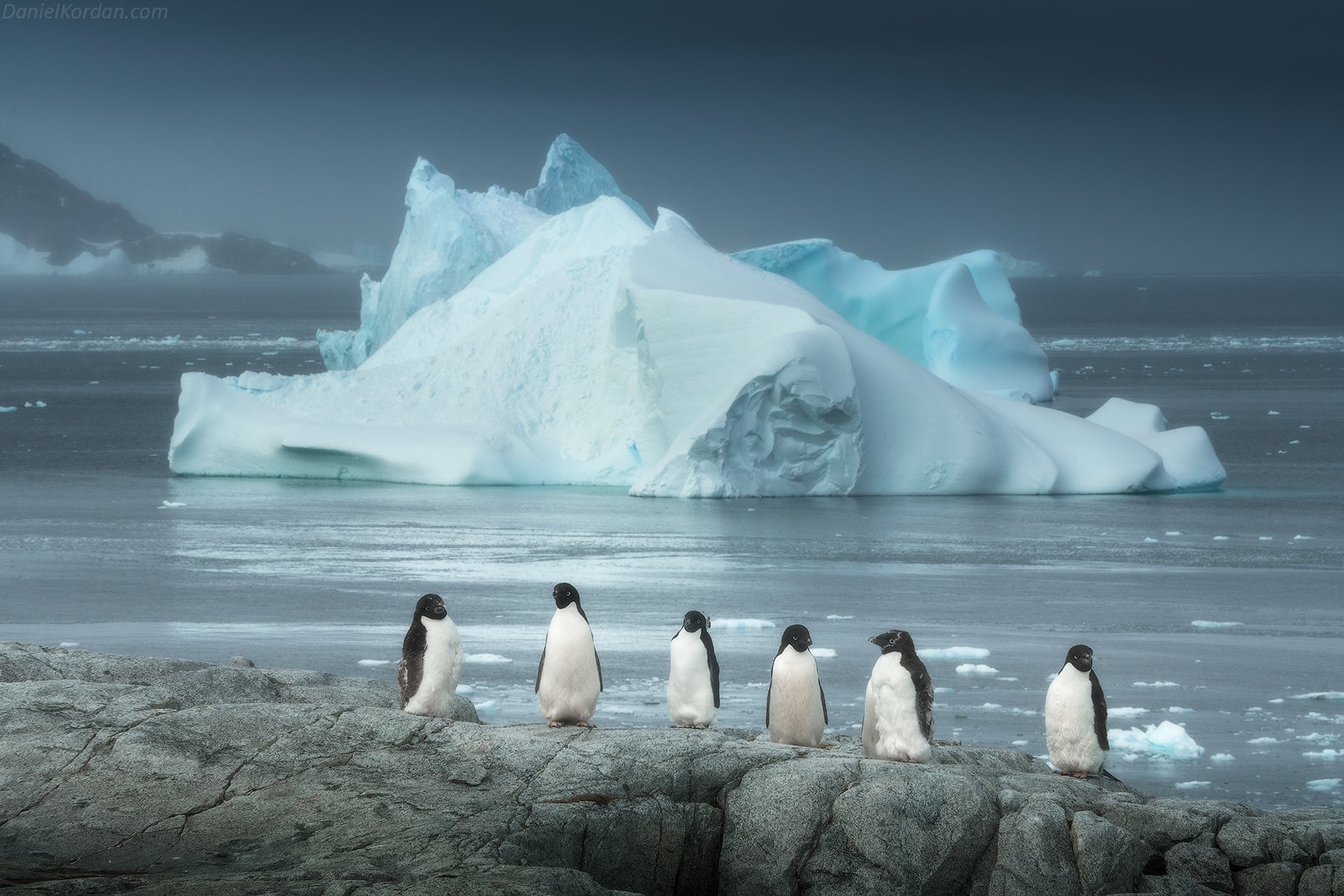 Adélie penguins have a tuxedo-like colouration. Photo by: 'Daniel Kordan'.
Adélie penguins have a tuxedo-like colouration. Photo by: 'Daniel Kordan'.
Adélie Penguins are the second type of penguin that is endemic to the Antarctic, and the most widely spread penguin species in the world, residing along the entire coastline of the continent. Up to 71 centimetres tall and weighing six kilograms, they are not notable for being particularly large or notably tiny; what they are notable for, however, is their colouration, behaviour, and vast congregations.
The ongoing trope of penguins being dressed in tuxedos comes from Adélie Penguins. Their black and white feathers are separated starkly, and the black feathers conceal the bird’s red beak, making them appear monochromatic. Considering the hurried way they walk, they have often been compared to tiny business people, which has had a great influence on the media representation of all penguins.
 Baby penguins can be found on Antarctica's coasts in summer. Photo by: 'Daniel Kordan'.
Baby penguins can be found on Antarctica's coasts in summer. Photo by: 'Daniel Kordan'.
In terms of their behaviour, Adélie Penguins have been noted by many throughout history for their bizarre bravery and brazen behaviour. Having evolved far from any land-based predators, they are unafraid and often curious of human presence; in the past; there have been records of them running up to greet barking, slathering dogs that are straining at their chains to attack them. Today, this usually involves them playing with camera equipment and pecking at the shins of photographers.
Adélie Penguins have also been noted for their dramatic leaps from the ocean; they can propel themselves up to three metres in the air when making their way from sea to land or escaping the jaws of a predator. This ability is essential to their survival, considering that they tumultuous waves of the Antarctic slamming against the rocky coastline could easily kill such a small creature if it did not control its landing.
As a final note on Adélie Penguin behaviour, those that live in the Ross Sea can migrate up to 10,000 miles per year. They do this to ensure that they are never consumed in complete darkness during winter, by following the sea ice from their winter foraging grounds.
 Adélie Penguins are endemic to Antarctica. Photo by: 'Daniel Kordan'.
Adélie Penguins are endemic to Antarctica. Photo by: 'Daniel Kordan'.
In terms of their congregations, Adélie Penguins are incredibly impressive. Their breeding colonies, which they inhabit during summer from October to March, regularly are home to over half-a-million nesting pairs; in 2018, over one-and-a-half-million were discovered on the Danger Islands. These vast groups make for a spectacular sight, although the same cannot be said for the noise and smell.
There are over 250 separate breeding colonies, dotted all around the continent and its surrounding islands, and thankfully, this number is increasing.
Unlike Emperor Penguins, Adélie Penguins lay their eggs in more coastal regions and take turns incubating them. Their young are thus more vulnerable to predation by seabirds. Giant Skuas and similar birds of prey will even occasionally attack adults, although, like their larger cousins, their biggest threats are Orcas and Leopard Seals.
Chinstrap Penguins in Antarctica
 A chinstrap penguin feeding its young in Antarctica. Photo by: 'Daniel Kordan'.
A chinstrap penguin feeding its young in Antarctica. Photo by: 'Daniel Kordan'.
Chinstrap Penguins are a medium-sized penguin, slightly taller but slightly lighter than Adélie Penguins, named after the black line beneath their eyes and beak which gives them the illusion of them wearing a helmet.
Chinstrap Penguins do breed in Antarctica, but are more commonly found on sub-Antarctic and South Pacific islands; some have even been found as far north as Saint Helena. They follow similar breeding habits to Adélie Penguins, and have a similar diet of fish, small crustaceans and squid.
 A mating couple of chinstrap penguins in Antarctica. Photo by: 'Daniel Kordan'.
A mating couple of chinstrap penguins in Antarctica. Photo by: 'Daniel Kordan'.
They are also similarly threatened by Leopard Seals; in fact, it is thought that up to 20 percent of Chinstrap Penguins from some Antarctic colonies are killed by Leopard Seals every year. This species is also vulnerable to predation by Giant Petrels and Antarctic Fur Seals.
Chinstrap Penguins are most noted for their unusually aggressive behaviour; while other species are noted for their placidity, curiosity or nonchalance, Chinstraps often engage with scuffles with each other, other species of penguin, and even people that encroach on their space.
Macaroni Penguins
Macaroni penguins are a crested penguin species found across Antarctica and the sub-Antarctic region throughout the summer. They are noted for the yellow feathers emerging from their foreheads, which curve back towards the nape of their necks to give the impression of bushy eyebrows.
For a crested penguin, Macaronis are quite large, although not particularly so when compared to other Antarctic species; they stand at around 70 centimetres tall, and weigh less than seven kilograms. They share a similar diet of small crustaceans, squid and fish, and similar predators, of Leopard Seals, Orcas and large seabirds.
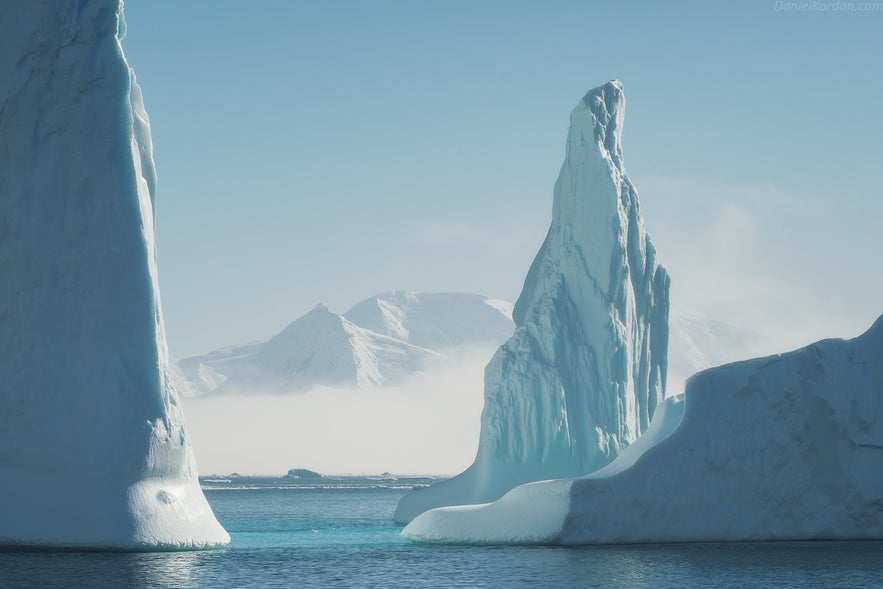 Macaroni penguins feed in the fertile waters of Antarctica in summer. Photo by: 'Daniel Kordan'.
Macaroni penguins feed in the fertile waters of Antarctica in summer. Photo by: 'Daniel Kordan'.
Despite being the most numerous penguin species, Macaronis are in decline and considered vulnerable, largely due to marine pollution, overfishing and the decline of krill populations due to climate change.
In the Antarctic, Macaronis begin breeding earlier and leave the continent later than most other species; their colonies begin to form in October and often don’t disperse until May. During the winter months, this species resides in the sea, some travelling over 10,000 kilometres to the tropical waters of the Indian Ocean to feed.
In spring before the breeding season, these penguins moult, spending up to four weeks on land as their new insulating feathers regrow, during which time they do not enter the water or feed.
Gentoo Penguins
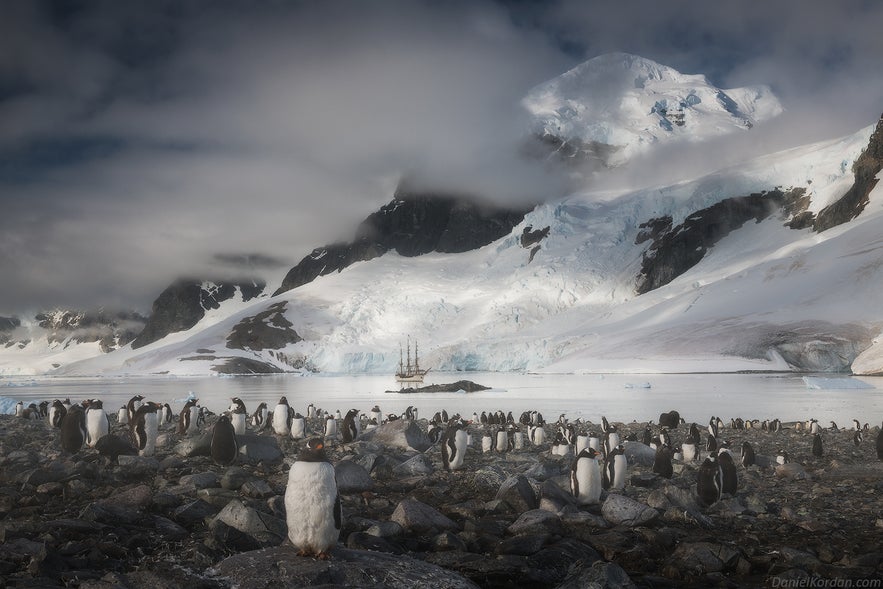 Antarctica is home to many colonies of Gentoo Penguins. Photo by: 'Daniel Kordan'.
Antarctica is home to many colonies of Gentoo Penguins. Photo by: 'Daniel Kordan'.
The final species of penguin that breeds on the Antarctic Continent is the Gentoo Penguin, though they are only found on the northernmost Antarctic Peninsula; they also nest over many sub-Antarctic Islands and southern South America. At up to 90 centimetres and eight-and-a-half kilograms, they are the third-largest penguin species, although it should be noted that they are smaller in the southern part of their range.
Gentoos are closely related to Adélie Penguins, having only diverged from the species 14 million years ago. They are distinguished by their size, their orange beaks and the white patch of feathers on their head.
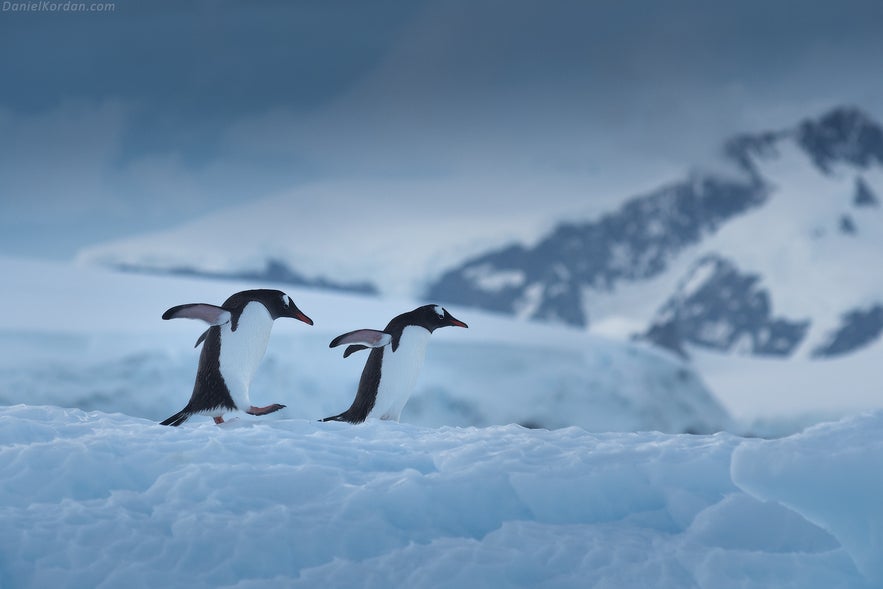 Two gentoo penguins travelling in Antarctica. Photo by: 'Daniel Kordan'.
Two gentoo penguins travelling in Antarctica. Photo by: 'Daniel Kordan'.
Gentoo penguins have some of the most interesting breeding habits of all Antarctic species. Unlike Emperors, who march over a hundred kilometres to make their colonies in safe locations, Gentoos will lay their eggs in a variety of places, from the coastline to a location significantly inland. They prefer ice-free surfaces, which are often prioritised on visits to the Antarctic by cruise or photo workshop, making them a common sight for visitors.
Also unlike Emperors, Gentoos are committed monogamists. They are even somewhat militant in this way of life, banishing penguins who cheat on their partners from the colonies. Furthermore, they are aggressively protective not only of their lovers and eggs but of the stones that encircle their nests, which are used as part of the courtship between males and females.
Penguins in the Sub-Antarctic
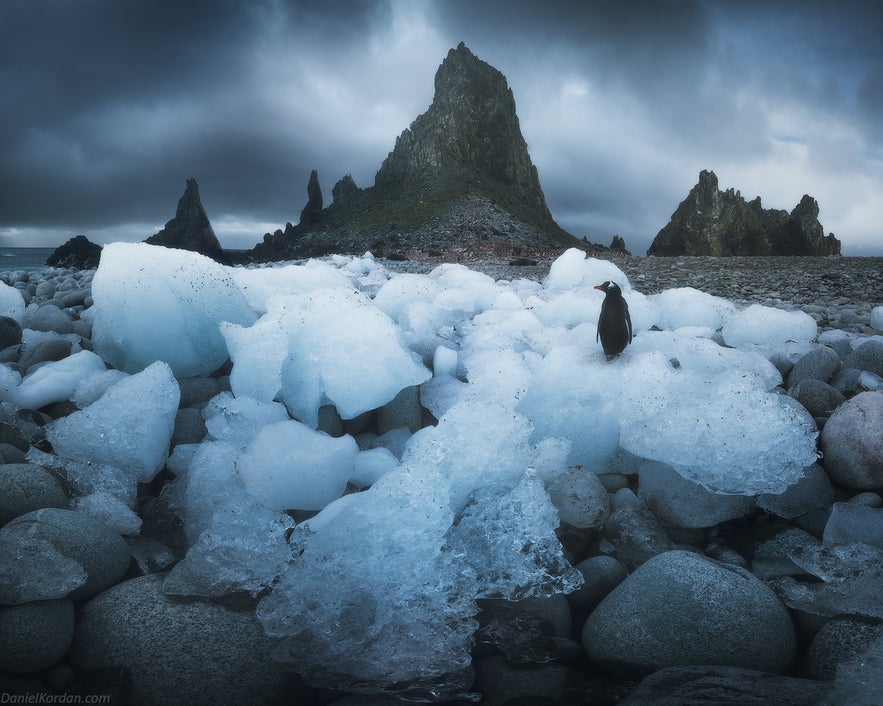 Eight species of penguin are found in Antarctica and sub-Antarctica. Photo by: 'Daniel Kordan'.
Eight species of penguin are found in Antarctica and sub-Antarctica. Photo by: 'Daniel Kordan'.
Though the five species listed above are the only penguins that can be found on the Antarctic continent, three more can found on sub-Antarctic islands:
-
Southern Rockhopper Penguins: A small, crested penguin species, standing less than 60 centimetres tall, Southern Rockhopper Penguins can be found around the Falkland Islands and on islands in the south Pacific and Indian Oceans. They were named after the way they jump between rocks, rather than slide or waddle, to their destinations.
-
King Penguins: The second largest species of penguin, King Penguins can grow to a metre tall and weigh nearly 20 kilograms. Distributed across sub-Antarctic islands in the southern Atlantic and Indian Oceans, King Penguins are noted for rearing their young for over a year, until they are capable of surviving in the dangerous waters alone.
-
Magellanic Penguins: Magellanic Penguins are average-sized penguins that live in southern South America in sub-Antarctic waters. They are noted for the white stripes across their chests, necks and faces, and their vulnerability to oil-spills, images of which have helped raise awareness of this environmental problem.
- Check out this Patagonia Tour with Daniel Kordan
Seals and Sea Lions in Antarctica
 Many seals are well adapted to Antarctica. Photo by: 'Daniel Kordan'.
Many seals are well adapted to Antarctica. Photo by: 'Daniel Kordan'.
The shores of Antarctica may have been made famous by the penguins, but the seals and sea lions that share their territory are no less fascinating; they are the only other creatures on Earth that have managed to breed, rear their young and survive between the continent’s inhospitable land and frigid waters.
They are perhaps a little overlooked because seals and sea lions, or pinnipeds, live on all continents, in tropical, temperate and polar waters; many who live in coastal regions will have seen them. When most of these animals are observed, they are usually lazing on the shore or bobbing in the water, leading to a perception that they are loveable but not particularly fascinating.
 A seal chills in Antarctica. Photo by: 'Daniel Kordan'.
A seal chills in Antarctica. Photo by: 'Daniel Kordan'.
The seals of Antarctica, however, have attributes their cousins in warmer climes do not, which in some species crushes their reputation for being cutesy. Southern Elephant Seals are gigantic beasts that fight in bloody vicious battles; Leopard Seals are unpredictable and unforgiving predators that have been known to stalk humans as prey; and young male Antarctic fur seals, full of hormones, are known to unleash their aggression and pent up energy towards anything around them.
There are three other species of seal that live in Antarctica, however, that not only retain their reputation for cuteness but magnify it by having perhaps the most adorable babies in the animal kingdom.
Southern Elephant Seals in Antarctica
Southern Elephant Seals are the world’s largest species of seal and a common sight on the shores of Antarctica in summer. The males grow to nearly six metres long, and one specimen was recorded to be 5,000 kilograms - about as heavy as a large Indian Elephant. Whilst this gigantism is spectacular in and of itself, it is the behaviour of Elephant Seals that make them one of the most incredible animals to behold.
For male Southern Elephant seals, breeding is everything. Which individual gets to breed with the most females is determined entirely by size and strength. Just before the mating season, the males will come ashore, after spending a winter building up fat stocks, to establish their territory. When the females return, they will attempt to collect as many of them into their harem as possible, and do so with epic battles.
In these fights, two bulls will face off against each other, raising themselves on their flippers to show off their enormous chests, and bellowing through their proboscises. Often, the smaller male will retreat, but should it determine that the confrontation is worth fighting, then it will engage physically.
Using their inconceivable weight, they shove against each other, biting through their competitor's thick hides wherever possible, often causing raw sores and open gashes. These fights usually end with the most wounded fleeing from the victor, but many have proved fatal.
This battle for dominance and fertility rights does not just occur at the beginning of the season; throughout summer, the bull Elephant Seals will have to protect their harem from younger, smaller males waiting for their guard to slip. They will often stay out of the water and thus not eat for three months at a time, relying on their fat stores to conserve them.
It is estimated that only one in six Elephant Seal males will get to have a harem, with the others only having a chance at mating if they manage to sneak onto another’s territory.
Bulls can have dozens of females at a time, who have very little choice in their breeding partner; they are dwarfed by their male counterparts, often not even a quarter of their weight. Many are injured by the extreme aggression of males, either when they are charging towards a competitor or during the mating process. Furthermore, their cubs are incredibly vulnerable to be crushed or suffocated by their oblivious, aggressive fathers.
When they are not breeding, rearing their cubs or moulting, Elephant Seals spend their time alone at sea hunting. They are one of the world’s deepest diving creatures, able to reach two kilometres beneath the surface when hunting for squid and fish. Their diet, however, is varied, as they also eat crustaceans, krill and algae.
In spite of their enormous size, weight and strength, Elephant Seals do have a few predators. When young, they can fall prey to Leopard Seals, whereas even full-grown bulls succumb to the jaws of the mighty Orca.
Leopard Seals in Antarctica
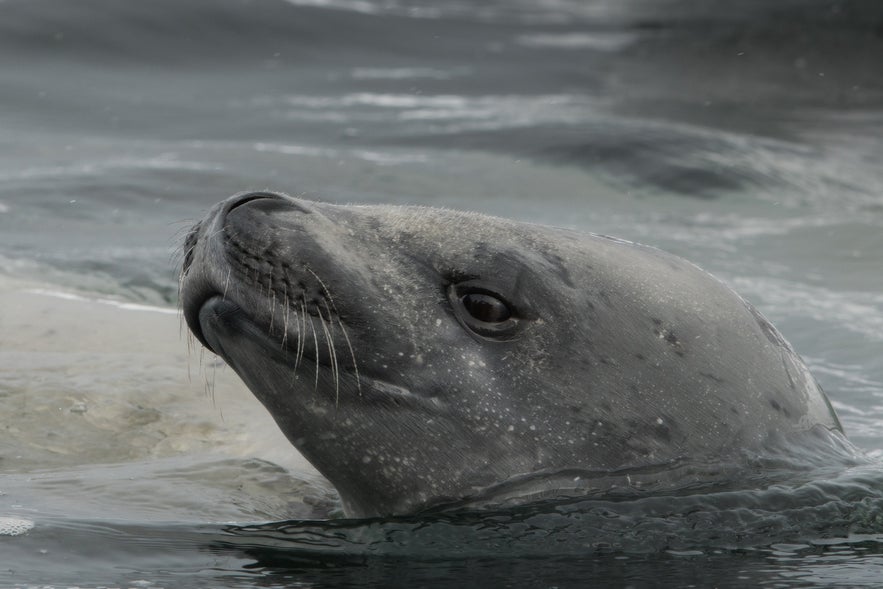 Leopard seals are an apex predator in the ocean. Photo by: 'Daniel Kordan'.
Leopard seals are an apex predator in the ocean. Photo by: 'Daniel Kordan'.
Leopard Seals are an endemic species to Antarctica and unlike any other species of seal on Earth.
Everything about their appearance speaks to their nature as a merciless apex predator, from a body that exudes muscularity to a face that appears to be as much reptile as it is mammal. Their mouths and canines are disproportionately large, and though their bodies are long, with females reaching 3.5 metres, they are light, reaching just 600 kilograms, to maximise their agility underwater.
Leopard Seals almost exclusively reside on the pack ice that encircles Antarctica, though on rare occasions they have strayed as far as Australia. When young, they will feed largely on squid, krill and fish, but upon reaching adulthood, their diet will begin to reflect their appearance.
Lying in wait at the edge of the ice, just submerged in the water, Leopard Seals have adapted to ambush all kinds of penguins and seals as they enter the sea. As soon as they unsuspectingly break the surface, the predator will seize them by the teeth from behind, shaking them furiously until they succumb to the wound. Larger prey they make take several bites out of or attempt to drown.
Leopard seals are remarkably influential predators; it is believed that 80% of Crabeater Seal pups that die fall victim to them, and nearly that rate of adults have wounds from attacks.
The animals of the Antarctic have not evolved to fear people due to their isolation, which regarding most animals is a delight; in the case of the Leopard Seal, however, this has proven worrisome. On at least three recorded occasions, these animals have attacked humans, and in at least two of those occasions, they exhibited stalking behaviour first.
-
1914-1917: A member of the crew of the famous ‘Endurance’, an Antarctic exploration vessel captained by Ernest Shackleton, was chased by a Leopard Seal when lost looking for food on land. He was rescued when his cries for help alerted a fellow crew member, who shot it.
-
1985: Gareth Wood, a Scottish Explorer, was almost dragged off of the ice into the sea by a Leopard Seal, which bit his leg twice. It was only deterred when those he was with kicked him free.
-
2003: Kirsty Brown, a biologist working with the British Antarctic Survey, was tragically the first and only person known to be killed by a Leopard Seal. While snorkelling, she was dragged to a depth of 70 metres for six minutes, suffering 45 injuries.
In spite of their numbers around Antarctica, Leopard Seals are hard to study due to their preference for sheet ice as a habitat. They breed between December and January and pups only stay with their mothers a month after birth, yet little else is known about their life cycle.
What has been established, however, is that they communicate with many sounds beneath the water during summer. It is believed that these acoustic messages have several different meanings, such as to attract a mate, to establish territory, or to make contact with a pup.
Crabeater Seals in Antarctica
 Crabeater Seals, Antarctic natives, are the most common species of seal. Photo by: 'Daniel Kordan'.
Crabeater Seals, Antarctic natives, are the most common species of seal. Photo by: 'Daniel Kordan'.
Crabeater Seals are the world's most abundant seal species; it is believed that there could be up to 75 millions of them. The reason for their abundance is because of how they have evolved to feed on the vast amount of krill that bloom in the waters of their habitat; in spite of their name, they are largely filter-feeders and do not eat crabs
In spite of their numbers, Crabeater Seals are not always easy to observe because of their preference for free-floating pack ice. Here, they give birth, raise their young, socialise and meet their mates. Groups of up to 1,000 young seals have been witnessed together, although most Crabeater adults travel alone of with just a few companions.
Unlike most other seals, Crabeaters have adapted to move swiftly on snowy land. Using their flipper and undulations in their belly, they can slide along the ice at speeds of up to 26 kilometres an hour. They are also powerful swimmers, capable of breaching from the water, although this is usually only seen in the presence of Orcas or Leopard Seals, their only predators.
Weddell Seals in Antarctica
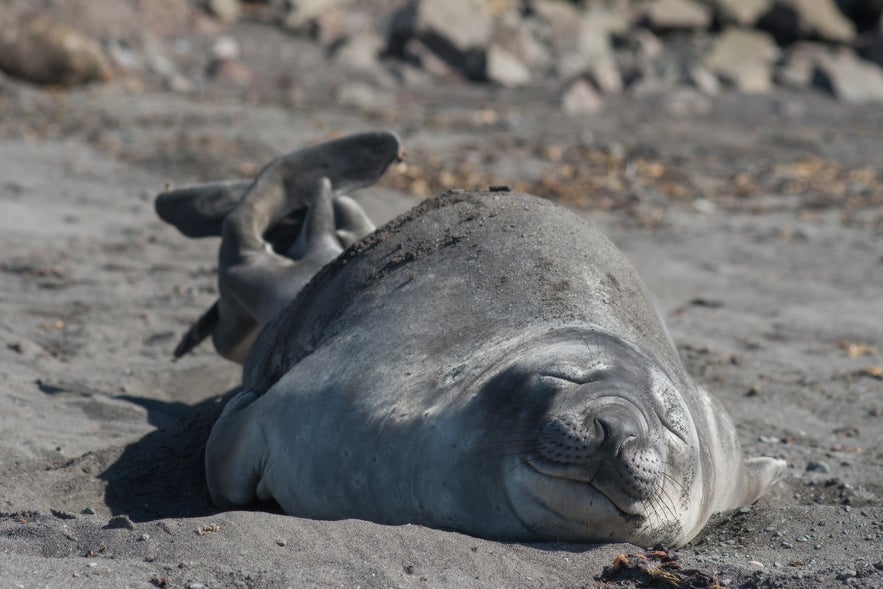 Antarctic Weddell Seals are easily idenitfied by their smiles. Photo by: 'Daniel Kordan'.
Antarctic Weddell Seals are easily idenitfied by their smiles. Photo by: 'Daniel Kordan'.
Weddell Seals are another species endemic to Antarctica; they have, in fact, the southernmost distribution of any seal, staying close to the coastline. They are renowned for being the easiest of all Antarctic seals to observe, study and approach, due to their docile - to the point of disinterested - nature around humans.
Weddell Seals are usually only seen, however, during summer; they spend their winters in the water to avoid the bitter winds, breathing through holes they dig in the pack ice. They breed on fast ice, where males will travel from colony to colony of concentrated females, attempting to spread their genes as much as possible, usually around December after the females have given birth.
Like Leopard Seals, Weddells have been heard making a range of vocalisations, the most important of which seems to be between mothers and their pups. Males and females can also communicate with these noises through ice if they are in close proximity, and breathing holes are thought to be used as a way to transfer messages to those at the surface from those beneath the water.
Weddell Seals are best identified by the shape of their mouths, which make it appear as if they are smiling.
Ross Seals in Antarctica
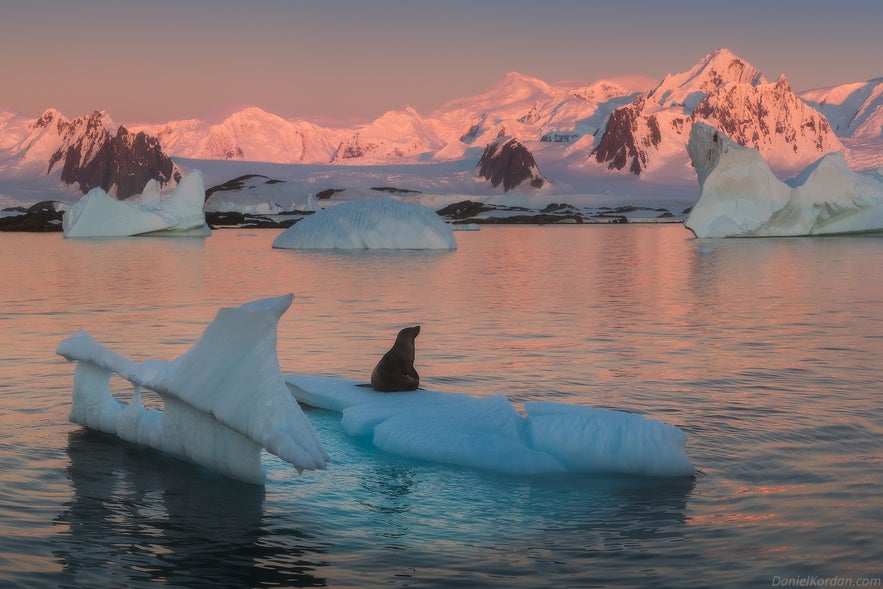 Ross seals are the least understood of the Antarctic seals. Photo by: 'Daniel Kordan'.
Ross seals are the least understood of the Antarctic seals. Photo by: 'Daniel Kordan'.
Ross Seals are the smallest and least understood seals in Antarctica. Growing to just over two metres and two hundred kilograms, they congregate on pack ice, which is difficult for visitors and researchers to access.
Estimated at around 130,000 individuals, it has been determined that they give birth in November and wean their young in just four weeks; that they vocalise in a similar way to the species mentioned above; and that they live largely on fish and squid. Very little else, however, is known about their habits and behaviour.
Fur Seals in Antarctica
 Antarctic fur seals are not actually seals but sea lions. Photo by: 'Daniel Kordan'.
Antarctic fur seals are not actually seals but sea lions. Photo by: 'Daniel Kordan'.
Antarctic Fur Seals are the only sea-lions that live in Antarctica; they can be found on the Antarctic Peninsula, although the vast majority breed in St. Georgia. Fur seal is a term used across many sea lion species, but as these animals have external ears and the ability to walk on all fours, they are not true seals.
At up to two metres long, Antarctic Fur Seals are not particularly large; their diet is reflective of this, largely consisting of krill and squid. Young males, however, can be rather aggressive and have been witnessed attacking penguins either for food or in an attempt to forcibly copulate with them. This is likely a result of sexual frustration due to the territorial nature of stronger males during mating season and their claim over breeding rights.
In this season, which starts in late October, bull Fur Seals behave similarly to Elephant Seals, in that they establish their harems in a show of dominance, and fight off any who encroach upon the females. Though their means of fighting is similar, more Fur Seals die from these conflicts than Elephant Seals.
Whales in Antarctica
 Antarctic waters in summer bloom with krill, attracting many whales. Photo by: 'Daniel Kordan'.
Antarctic waters in summer bloom with krill, attracting many whales. Photo by: 'Daniel Kordan'.
In summer, the waters of the Antarctic, in spite of their frigidity, are teaming with life, with vast blooms of plankton feeding billions of krill, which in turn become prey for a range of other creatures. These tiny animals, in fact, make up the diet of the largest creatures that have ever existed on Earth, the migratory great whales.
Blue Whales and Fin Whales, which reach nearly 30 metres long and up to 173 and 114 tonnes respectively, come here to feast after their breeding season. Unlike anywhere in their distribution during winter, these animals will even form loose pods in Antarctic waters, making the continent one of the only places on Earth where you may see - and even photograph - many of these colossal but benevolent creatures together.
It is not just these giants that migrate to Antarctica for the plentiful supplies of food. If whale-watching enthusiasts were to name the two most impressive animals for their surface behaviour, it would likely be the Humpback Whale and Southern Right Whale, and both of these animals are also summer residents.
Humpbacks are the face of whale-watching, renowned for their dramatic breaches and fluke slaps, and the way they raise their tail before a deep dive. Though much lesser known due to their limited range and the way whaling devastated their populations, Southern Right Whales are similarly acrobatic at the surface.
Both of these whale species are also unique due to their unusual appearances; Humpbacks are knobbly with the largest fins in the animal kingdom, often compared to wings, whereas Southern Right Whales are very rotund, have a strangely curved mouth, and are usually covered in barnacles. They are both also notably large animals, up to 16 and 15 metres long respectively.
Other great whales, lesser-known due to the smaller size and more humble surface behaviour, also migrate to the Antarctic, including several species of Minke Whale.
All the whales mentioned so far have been baleen whales; that is to say that they are filter feeders, who consume food not with teeth but with keratin plates from their upper jaw that separate water from their tiny prey. The Antarctic waters, however, are also notable for being home to some incredibly impressive toothed whales.
The Sperm Whale is the most significant of these. Reaching over 20 metres and nearly 60 tonnes in extreme circumstances, it is the largest carnivore on Earth; it also has the largest brain of any animal and is the second deepest diver, able to reach depths of up to three kilometres. In the Antarctic waters, only adult males can be found; though these do not school as the females do in more temperate climes, they are much larger. They are not coastal animals, however, preferring the deep waters off the continental shelf where they can seek out their favoured prey, the colossal squid.
Several other deep-diving toothed whales reside in the waters of the Antarctic, although these are beaked whales, one of the least understood families of mammal in the world; many species have only been identified by odd bones and sightings. These elusive creatures avoid human contact, make little impression when they come up to breathe, and spend the vast majority of the time far below the icy surface.
Dolphins in Antarctica
The most notable dolphin species that reside in Antarctic waters is the largest and one of the most recognisable; the Orca, or Killer Whale. Orcas are considered the world's most successful animals in terms of range, surviving over the greater area than even humans and rats; they live in every ocean, and in the southernmost seas they thrive.
Apex predators wherever they swim, Orcas are renowned for their incredible intelligence, merciless hunting techniques, and dramatic size, with males exceeding ten metres long. At the surface, they are beloved by whale watchers for the way they breach, socialise and interact with boats.
 Orcas in the Antarctic are seen often from boats and ships. Photo by: 'Daniel Kordan'.
Orcas in the Antarctic are seen often from boats and ships. Photo by: 'Daniel Kordan'.
In the Antarctic, they even exhibit some unique behaviours; it is one of the few places on Earth, for example, where they 'spy-hop', lifting their heads from the waters to look out for prey on lands.
Across their range, Orcas adapt to their habitat, eating what is most easily available. In many areas, this means they feed primarily on fish, posing no threat to larger marine animals. In Antarctica, however, this is far from the case. Their diet in this region is comprised largely of penguins and seals, including adult Elephant Seals, and they have also been witnessed hunting whales up to the size of adult Fin Whales.
Their hunting techniques are as aggressive as they are intelligent. Orcas mount and tip ice flows, tossing their prey into the water; they surge onto shores to snap up seals or penguins too close to the surf; and they wait beneath ice sheets for an unwitting animals to hop into their paths.
Orcas thrive on the brutal conditions of the Antarctic with their brains and brawn; other dolphins, however, have adapted well to the environment without needing to. Southern Right Whale Dolphins, for example, often follow around their namesakes, which take them to fertile feeding grounds; they also breach often, likely to look out for birds flocking around a source of food.
Hourglass dolphins, meanwhile, are a very unique species, stunningly patterned with a black and white hourglass across their bodies, which reside in deep Antarctic and sub-Antarctic waters. Here, they have plentiful food and no predators (Orcas have never been seen hunting them), and they are conveniently distant from major shipping routes and fishing areas, allowing them to avoid many of the threats to the ocean we have introduced.
Both of these species are spectacular to see when travelling to and from the Antarctic continent due to their love of bow-riding and the size of their groups, which can number up to a hundred individuals. Southern Right Whale Dolphins and Hourglass Dolphins often share pods with each other and other marine mammals.
Long-finned Pilot Whales are another species of dolphin that can be found in the Antarctic, reaching nearly seven metres long. They travel in family groups of usually less than a dozen individuals, but they often congregate into ‘super-pods’. In spite of their size and unverified reports of them attacking marine mammals, these dolphins survive largely on a diet of squid and fish.
Though these are the only four species that reside in Antarctic waters, several other dolphins can be encountered in the sub-Antarctic when travelling from South America to the continent. The minuscule but acrobatic Commerson’s Dolphin and the more serene Peale’s Dolphin are both endemic to these waters, and though the Dusky Dolphin can also be found around New Zealand, it is one of the most active at the surface and incredible to observe.
Birds in Antarctica
 Many birds migrate to Antarctica in summer to feed. Photo by: 'Daniel Kordan'.
Many birds migrate to Antarctica in summer to feed. Photo by: 'Daniel Kordan'.
Antarctica is the summer home for far more birds than the penguins discussed above. These avian creatures are often the first creatures seen as one embarks on a ship towards the southernmost continent, sailing through the skies or bobbing on the waters, and they are as varied as they are beautiful.
Most notable is, of course, the wandering albatross. This migratory bird has the largest wingspan in the animal kingdom, able to stretch them up to 3.5 metres apart, and is a common sight in the skies and waters of the sub-Antarctic.
Several other species of albatross, such as the similarly giant Southern Royal Albatross and mottled Sooty Albatross also breed and roost in the region.
Antarctic is also home to the smallest seabirds, austral Storm Petrels, which nest on the continent and its surrounding islands. These birds feed on the plentiful krill by hovering just over the surface of the water and plucking them out with their beaks.
 South Polar Skua blend in perfectly with the Antarctic landscapes. Photo by: 'Daniel Kordan'.
South Polar Skua blend in perfectly with the Antarctic landscapes. Photo by: 'Daniel Kordan'.
Arctic Terns, in spite of their name, spend the southern summers on the edge of the Antarctic sea-ice, where they dive for small fish from the sky. Cormorants, such as the Antarctic Shag, are most often seen diving from the water’s surface to hunt, being adept swimmers.
Skuas, like the South Polar Skua, tend to wait until they see another bird get a catch in order to rob it. These birds are also aggressive when nesting, behave like Arctic Terns in the northern hemisphere as they attack the heads and faces of any who get too close to their eggs.
 Kelp Gulls are vicious Icelandic predators and scavengers. Photo by: 'Daniel Kordan'.
Kelp Gulls are vicious Icelandic predators and scavengers. Photo by: 'Daniel Kordan'.
There are also several species of gull, the most notable of which is the Kelp Gull. This vicious, opportunistic bird has been witnessed feeding on baby penguins in the Antarctic, and further afield, baby seals and the skin of whales attempting to breathe too; it is unknown if they do the same here, and scientists are concerned that even if they don’t presently, the behaviour may spread.
Another notably aggressive bird is the Southern Giant Petrel. Though it primarily feeds on fish and krill, when summer arrives on the Antarctic Peninsula, it is a menace to penguins and other seabirds. Though they most often kill and eat chicks or sick animals, they have also been known to routinely attack and feed on adult birds, killing them in brutal ways such as by drowning.
- Check out this Complete Guide to Photographing Puffins in Iceland
Other Animals in Antarctica
 Few animals can survive on Antarctica. Photo by: 'Daniel Kordan'.
Few animals can survive on Antarctica. Photo by: 'Daniel Kordan'.
Antarctica has one animal on its mainland that has not been mentioned: the six-millimetre long Antarctic Midge. That’s it.
No other species has managed to take hold here. Black and brown rats, which followed humans to every corner of the globe, have made no foothold in the continent; no livestock has been brought here, as none can endure the conditions. Even humans, who have set their ambitions to settling in space, have formed nothing more than a few basecamps and research centres.
The animals that live in the Antarctic are all the more special for the fact that they and they alone have managed to thrive in the world’s most inhabitable land and seas. Either through size and strength, such as with the Elephant Seal and Orca; cooperation as a group, such as with the Emperor Penguin and Hourglass Dolphin; or through evolutionary adaptation to this icy world, such as with the Crabeater and Leopard Seal, the creatures of this continent are a testament to how life can flourish in the most inhospitable places.
Explore the incredible landscapes of Antarctica as you immerse yourself in its nature and wildlife. Join this Antarctica Photography Expedition with Daniel Kordan in 2020!
